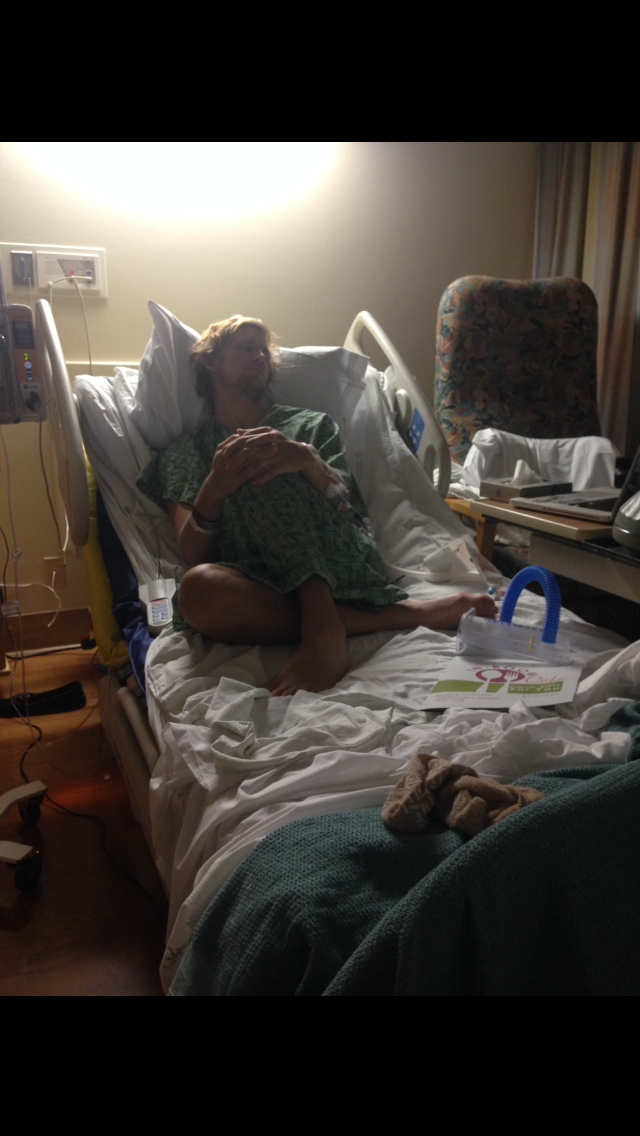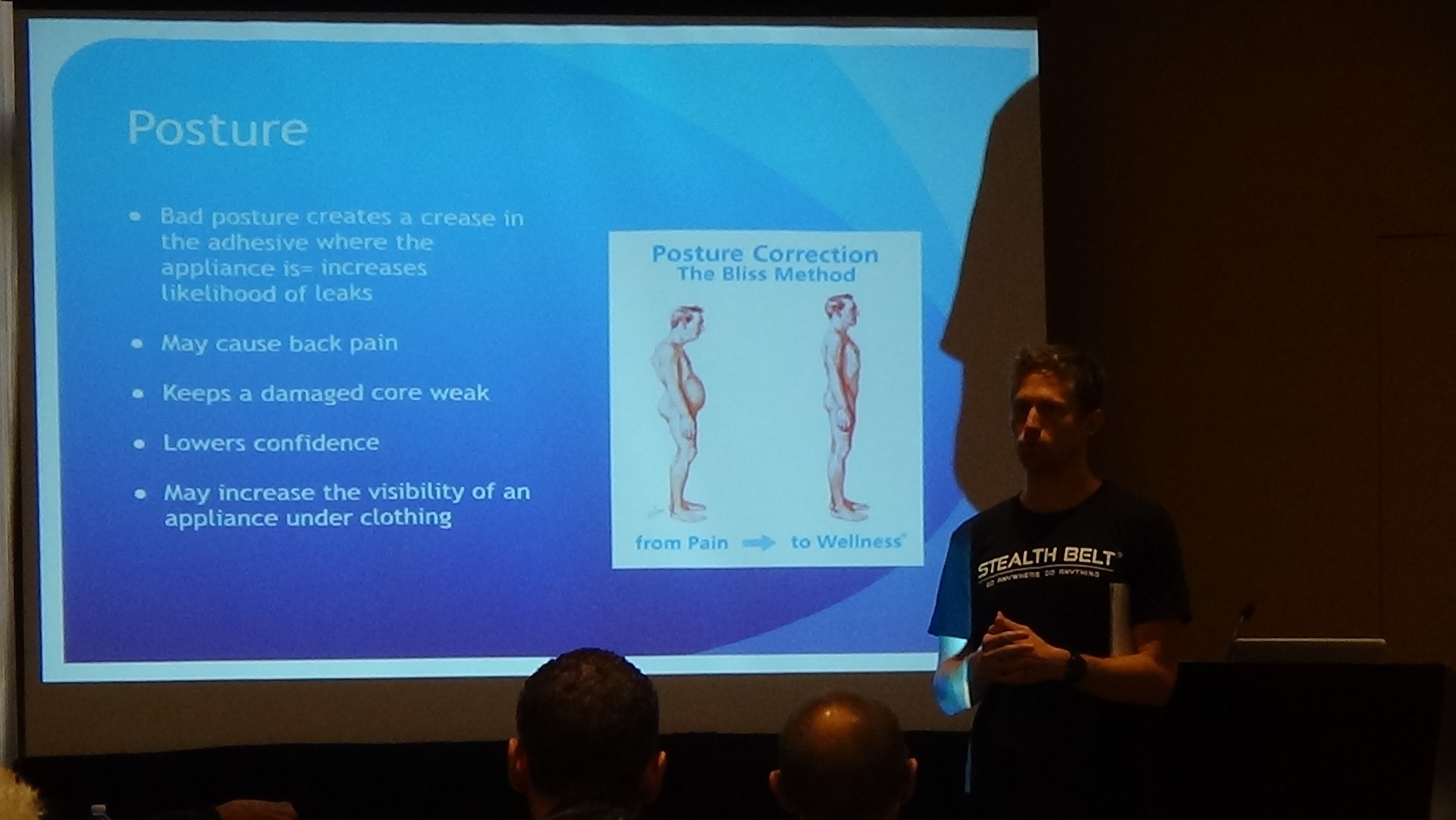The Benefits of Proper Posture and Functional Movement for Ostomates

How many times were you told to sit up straight while growing up? Parents, teachers, babysitters; they all seemed to want us sitting up straight, but did any of them ever say why it is important? It's so much more comfortable to slouch back in that chair or to allow gravity to hunch us forward towards the computer screen. Why should we do something that is less than the most comfortable option? Personally, I’ve always needed to really understand why I was doing something before I agreed to blindly start doing it; I was the annoying kid who incessantly asked “why?” at every opportunity.  Thankfully I’ve matured (slightly) since then and now have the tools to answer most of my own annoying questions like, "why should I be concerned with hydration?". My aim now is to answer why it is important to have good posture with an ostomy by looking at the general benefits of standing tall, dissecting the particular causes and effects of bad posture among ostomates, and then offer some tips on how to improve posture and functional movement patterns.
Thankfully I’ve matured (slightly) since then and now have the tools to answer most of my own annoying questions like, "why should I be concerned with hydration?". My aim now is to answer why it is important to have good posture with an ostomy by looking at the general benefits of standing tall, dissecting the particular causes and effects of bad posture among ostomates, and then offer some tips on how to improve posture and functional movement patterns.
I’ll start with some of the universal benefits of posture that apply to everyone:
Along with the obvious aesthetic benefit of being slightly taller, good posture can help alleviate pressure on your joints and muscles, and even organs! To illustrate how this happens, I like to think of the body as a building or tower. You can make a building 100 stories tall as long as you stack the weight properly, but can you imagine what would happen if you had stacked a few floors off center and then tried to keep building straight up? We’ve all played Jenga...  The building’s integrity would be compromised where the weight wasn’t being stacked properly, putting the entire structure at risk. While your body probably won’t collapse on itself in the same way a building might, the central idea is the same - poor posture will put more strain on the areas that are not stacked correctly.
The building’s integrity would be compromised where the weight wasn’t being stacked properly, putting the entire structure at risk. While your body probably won’t collapse on itself in the same way a building might, the central idea is the same - poor posture will put more strain on the areas that are not stacked correctly.
Aligning your body properly is also going to allow you to breathe easier. Having proper posture will allow your diaphragm to expand, making it easier for the complex system of muscles that draw in air to your lungs to function properly. According to this study by the Journal of Physical Therapy Science, those with forward head posture had significantly weaker accessory respiratory muscles, concluding that, "when treating patients with forward head posture or lung dysfunction, improvements in respiratory function through the correction of posture and the strengthening of weakened accessory respiratory muscles may be clinically important”. The essential take away from that study is that good posture is clinically proven to help you to breathe easier. *sigh of relief*
Aside from literally helping you to breath easy, there is a mountain of evidence that suggests that standing tall has a big impact on confidence and stress reduction as well. According to a study done in The Journal of Bodywork and Movement Therapy, there is a direct correlation between posture and emotions, stating that, "posture can affect emotions and emotions can affect postural presentation”, and that "emotions of happiness, success, confidence, and optimism are associated with an open expansive posture". This claim is further supported by social psychologist and author, Amy Cuddy, who’s studies have shown that simply standing in a power pose can reduce cortisol - the stress hormone - by up to 11% in a matter of just minutes.
Sitting up straight yet?
So far, all of the information gathered above is great for anyone with lackluster posture to know about, but the importance of good posture goes far deeper for those of us with ostomies. Any amount of time spent in a hospital is bound to add some degree of stress to your life, especially when the result is a bag of poo taped to your abdomen. Going back to a ’normal life’ can seem impossible, both physically and mentally. If you have an ostomy, you probably already know exactly what I’m talking about, but in case you don’t, here is one of literally hundreds of medical reviews that have been published about the stressors relating to patient psychological health after stoma surgery. To add to all of this, there is also the fact that people who have ostomies are predisposed to having bad posture. I’ll use myself as an example:
When I was sick with colitis, I was in constant pain which caused me to hunch forward slightly. I also spent a lot of time in bed or sitting in a curled up position, and I was only ill for 8 months; many people with IBD go through years of this before surgery.  During the time that I was hospitalized for pain and eventually surgery, I sat in a hospital bed hunched forward and depressed with my situation. After surgery, the abdominal muscles that make good posture possible had just been cut open with a knife and were extremely fragile and weak. I was also adjusting to the fact that there was a medical device attached to my abdomen that I wasn’t particularly accepting of, resulting in a hunching forward to ‘hide’ that area of my body. While this is based on my experience, I don’t think it’s a stretch to assume that there are many others with ostomies who can relate to these factors that contribute to poor posture. Now that we’ve determined some of the causes for bad posture among ostomates, we can look at how it affects daily life with the bag.
During the time that I was hospitalized for pain and eventually surgery, I sat in a hospital bed hunched forward and depressed with my situation. After surgery, the abdominal muscles that make good posture possible had just been cut open with a knife and were extremely fragile and weak. I was also adjusting to the fact that there was a medical device attached to my abdomen that I wasn’t particularly accepting of, resulting in a hunching forward to ‘hide’ that area of my body. While this is based on my experience, I don’t think it’s a stretch to assume that there are many others with ostomies who can relate to these factors that contribute to poor posture. Now that we’ve determined some of the causes for bad posture among ostomates, we can look at how it affects daily life with the bag.
Imagine you need to get something that you keep underneath the sink; how do you get to it? How about picking up a bag of groceries you set down on the kitchen floor? Chances are you bend over with your back and reach down for them, almost everyone does. It's the easiest way to do it after a lifetime of dysfunctional movement patterns, but there are reasons why moving in this way can cause problems. Now imagine again that you are in the lowest part of your bend forward to pick up that bag of groceries. Think about your stomach around the area of your ostomy while you are in that position. You are likely creating a folding point on your abdomen right where your appliance is. My theory is that every time you bend like this you put a little more strain on the adhesive that keeps your appliance in place.
Many of the ostomy manufacturers have appliances that are convex or have a floating flange to help allow for more bending in that area, but if this were a perfect solution why do so many people still deal with leaking problems? I believe it is because a flexible appliance is a 'band-aid' that attempts to cover a deeper issue: improper movement patterns and bad posture. To further illustrate my point using the band-aid analogy: try to remember the last time you used a band-aid for a small cut on your finger or elbow. Chances are the band-aid came off within a couple hours of putting it on. Even those clever butterfly shaped band-aids are still not as reliable as we’d like when they are placed at a bend point on our body. The same premise applies to our ostomy bags. I don’t want to confuse anyone about the purpose of convex or floating flange ostomy appliances, however. Much like a band-aid, even though it's not a perfect solution it is still better to have it in conjunction with good movement patterns than to go without. It would be unrealistic to not bend around that area of your body at all, but it is reasonable to move in ways that require far less folding in that location.
The portion of your abdomen on which the stoma is located is an area that is meant to be very strong and stable; we call it our 'core' because that is the central location of almost all of our movement - the core source of strength. There is a whole system of muscles that balance each other in that area in a very powerful and mechanical way, including your abdominal muscles, lower back muscles, gluteus muscles, hamstrings, and quads. Have you ever heard the phrase, “lift with your legs, not with your back”? It is a good way to conceptualize proper movement, but it takes some deeper understanding of how you might lift something with legs before you can just start doing it. I’m not going to go too far into detail today about the nuance of functional movement, but I will leave you with an example and a couple exercises that should help you get started.
Let’s think back to the example of the grocery bag on the kitchen floor; what is a functional example of how to pick it up? The most accessible movement for us to do this is to go into a partial squat, pushing out weight into our heels using our gluteus muscles, and using our core and low back to keep our spine straight and as elongated as possible. When lifting the bag up, you want to keep it close to the body so that it follows a straight line up from the floor in between your legs. You should be contracting your glute muscles to lift the weight and keeping your arms straight down and your shoulders slightly pulled back. This will allow you to transfer all of the weight from the bag you are lifting up into your legs, which is the most powerful chain of muscles in the human body. Your arms should remain straight, acting more like the cables on a crane rather than the sources of actual power themselves. This is also why exercises like bicep curls are generally referred to as 'beach muscles'. They might look good but are essentially useless if you are moving your body correctly. The graphic image of correct vs. incorrect posture does a good job of illustrating the differences between movement patterns.
![]()
A good beginner exercise to work on this movement is to use a chair. When you go down into a squat, your abdomen, low back, and gluteus muscles should all be contracting to keep you in alignment. Keeping your spine straight and pelvis thrusted slightly forward will cause your butt to go out behind you as you bend down into your squat. Use a chair to sit into and stand out of, really focusing on using the muscles in your lower abdomen and glutes. As your progress, you can sit into lower and lower chairs. A good supplement to the chair squats is to do glute bridges. This exercise involves laying down on your back with bent knees. Press your heels into the ground using your gluteus muscles and engage your core to keep your spine in that aligned position.
I hope this article serves as a good starting point for understanding how to move in a way that will help you feel stronger, more confident, and help reduce issues with leaking ostomy bags. Over the next few months, I will be updating this page and adding more in-depth video and image-guided suggestions for improving in these areas. As always, I'd like to remind you that I am not a medical professional and that this information is based on my own experience. I highly recommend working with a physical therapist for a short time to learn how to do these things properly with the in-person guidance of a licensed professional. I know for a fact that spending time fixing these areas of my life have improved my experience with an ostomy, and I strongly believe they can for you as well! Keep Rollin' everyone! #NoColonStillRollin
- Rosário, J. L., Diógenes, M. S. B., Mattei, R., & Leite, J. R. (2016). Angry posture. Journal of Bodywork and Movement Therapies.
- Cuddy, Amy. Presence: Bringing Your Boldest Self to Your Biggest Challenges. New York: Little, Brown and Company, 2015.
- https://www.ncbi.nlm.nih.gov/pubmed/24161637 (Post op stress article)
- http://onlinelibrary.wiley.com/doi/10.1002/ejsp.607/epdf?referrer_access_token=-0qMrQUVI9IIcsKBLVaY804keas67K9QMdWULTWMo8PH2oNaswuZ5O4y8OEZb_9cAzkHRotJF22NNKauBRIsqJ8EFbYMlzcNcqbJKH3RAr0FLhAS-r2tAjqH3MAaND3tRXxbzAHH_-XjbckVP-LtpgLQxhN6r7cxvVSLV_-_sbeOgW30zWgwBnkKbAXxpAWUCRDzhQ4WJkl85iTSujrzWZ4lZLlLa4rS7Yc_W1PL7oHryOMZjTvjTQ3JNFf5jSe00jjDq5Yk1r5-C8nuRBnaiw%3D%3D (cognitive ability)
- Han, J. et al. (2016) Effects of forward head posture on forced vital capacity and respiratory muscles activity. Journal of Physical Therapy Science, 28(1) p. 128–131. (respiratory function)
